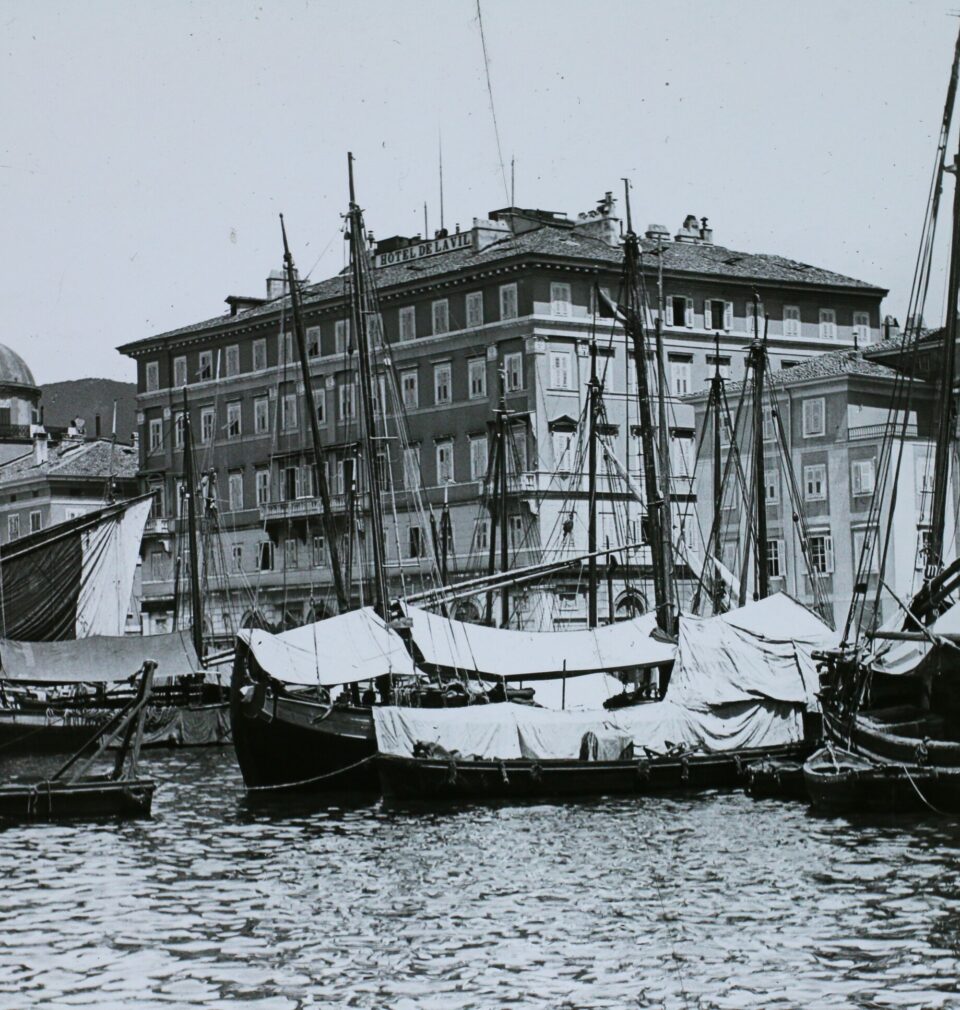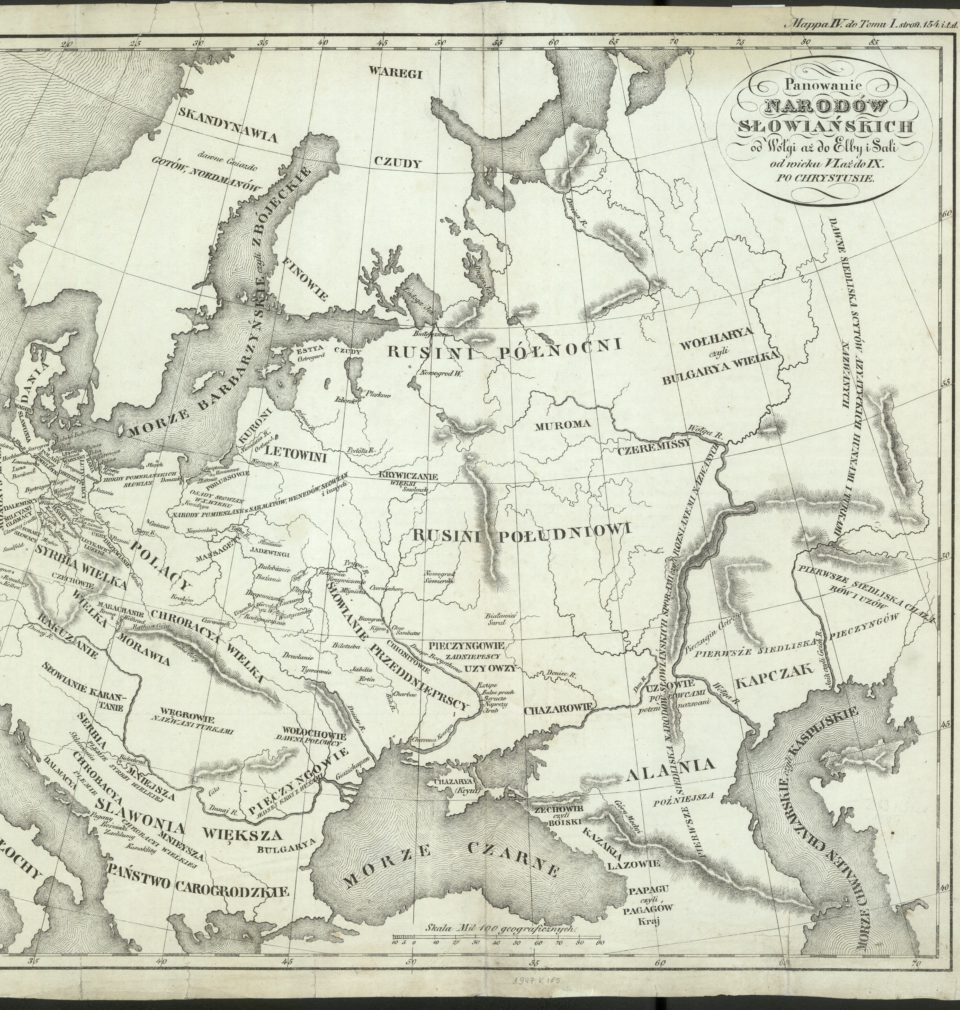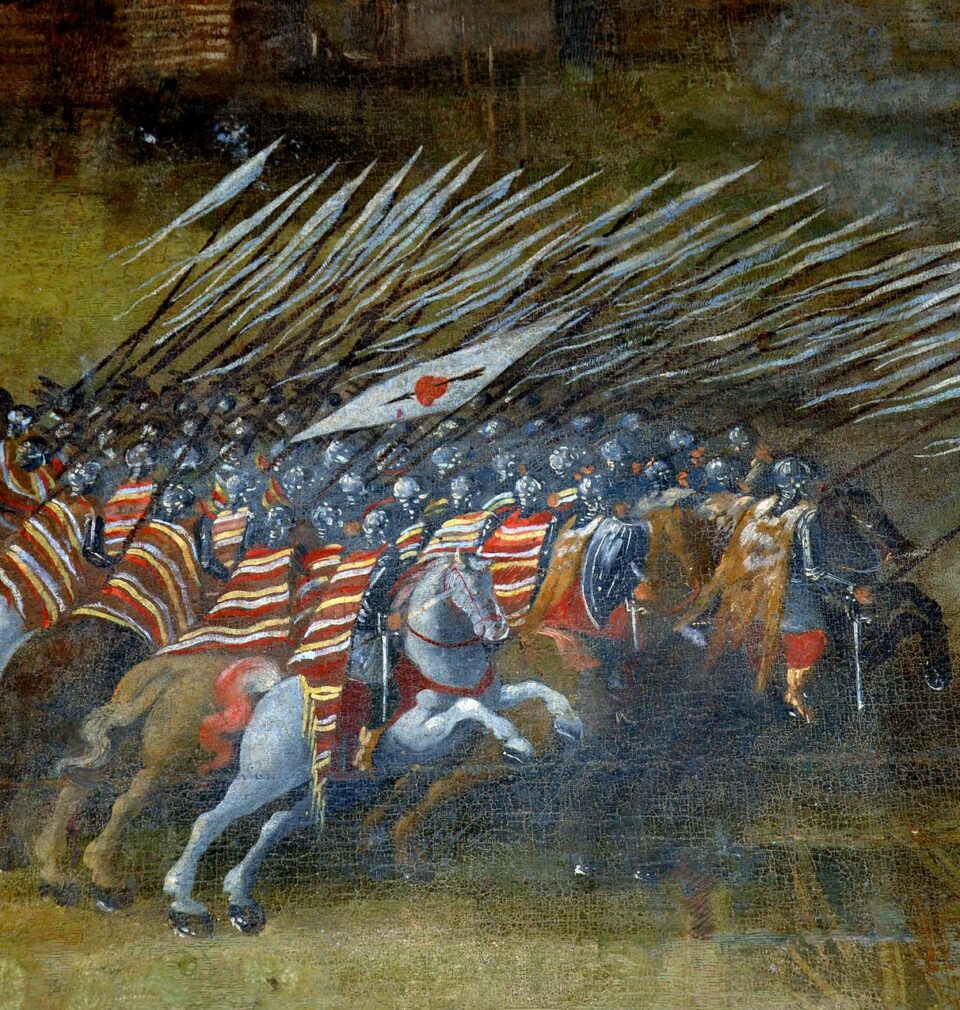
Symbols and Clichés
A Triestine Triptych (1)
Publication: 17 August 2021
TAGS FOR THE ARTICLE
TO THE LIST OF ARTICLESJoyce and his Triestine student met for the last time on a hot July day in the summer of 1914. One could feel tension in the air throughout the city. Mobilized men were mustering near the barracks, while crowds shouting bellicose slogans milled on the streets and piazzas. The teacher, upset and worried, rapped on his young friend’s apartment door. Then they looked through the windows of the pupil’s room at the building of the Italian consulate, which was surrounded by an angry crowd. Encouraged by loud shouts, several of them tried to tear down the Italian flag. Stones were thrown at the facade, some panes of glass shattered, there was yelling. Joyce was clearly perturbed, and he worriedly asked his young friend what was going to happen. Professor Zois, he said with a laugh, there will be war. This scared his teacher. Joyce said that he would depart. When the shouts of the crowd grew louder he shut his eyes, then he turned around, and while his pupil was still speaking he ran out of the apartment and the building without saying a word. The pupil laughed; history was being made outside. He understood that some people can derive ineffable joy from describing an oil lamp, but he was interested in other things. The roar of the crowd heralded the arrival of momentous times. He was drawn outside, into the whirlwind[1].
Joyce’s pupil in Drago Jančar’s short story is a young Triestine Slovene and later professor of law, named/called Boris Furlan. He will only learn, with great surprise, that his teacher had become a famous writer, from a newspaper obituary, nearly thirty years after Joyce – then teaching English in the Trieste Berlitz school – ran out of his apartment, and shortly afterwards left the town. Meanwhile, in 1920 spectres will return to the streets of Trieste. Down at the harbour, Italian soldiers will disembark. Young men in black uniforms will march about singing songs about youth and springtime. Then, they will start to dole out beatings to their political opponents. Furlan, newly graduated as a doctor of law, will attempt to keep calm. He will open a legal practice and become involved in the anti-fascist movement. Thanks to a tip-off, he will be able to flee the city in time. Later, he will read with terror of the political trials of his friends. But even in Ljubljana, where he will find shelter, he will not be safe when the Italians occupy the city in 1941. Via Switzerland and France, he will escape again, to England; meanwhile, the occupying forces in his homeland will sentence him to death in absentia. But before long his voice will become well known in Slovenia – as the voice of Radio London.
His decision to return is perhaps too hasty, perhaps an indication of naivety. Even as the country is being liberated by the partisans, and new people are organising new authorities, Furlan will return to Ljubljana, where he will be appointed dean of the law faculty. Two years later he will be arrested on charges of espionage for Britain. Why else would he, the Bawler of London, have needed to learn the language back then in Trieste? How disgracefully he had employed it! He had translated the “loathsome pamphlet” Animal Farm and circulated it among people of similar views. The two-week-long trial is to be a spectacle for the people. Furlan has already been sentenced to death once, though without his involvement. “This time you will be present,” sneers the prosecutor. He will spend two years in solitary confinement on death row, before being told he has been amnestied and his death sentence commuted to 20 years’ imprisonment. Four years later, owing to a heart condition, he will be paroled and will go to live in a small town in the foothills of the Alps. Until one evening in autumn 1953, some men will burst into his room. “He wants to sell Trieste to the Italians!” someone will cry. They will drag him out of the house, dump him into a wheelbarrow, and trundle him down to the river, to be claimed by the freezing, hurtling current.
For Slovenes, the figure of Furlan embodies many more meanings than his tragic fortunes recounted here – and they carry meanings enough of their own. Reflected in them are the 20th-century biographies of Central Europeans, for few in our region of Europe have managed to dodge the mantraps of History.
I am interested in something else – the town, through which streets the swirling north wind from the Karst seeks a path to the sea, howling above the clamour of the crowd. “History was being made outside,” Jančar tells us. Buildings have no less turbulent pasts than people.
I find portraits of Trieste at the dawn of the 20th century in the work of Scipio Slataper and Bobi Bazlen (both, like Furlan, born in Trieste in the last decades of the 19th century). Their city is alive, but with a different kind of movement, dictated by order and labour. Huge steamships sailing to Thessaloniki and Bombay lift anchor. Locomotives steam away to be rattling, a day later, across a bridge over the Vltava and powering into Germany with the Elbe. Telegraphs at the Stock Exchange tap out new bills of exchange from Turkey and Puerto Rico to multiply Trieste’s wealth. The city with its peculiar Italian dialect and the countryside with its Slovenian language are stapled together by the German-speaking Austrian bureaucracy. The Italians have their own Gymnastics Society, the Germans their Turnverein Eintracht, the Slovenians their Falcons – all of them bending and stretching in the name of their own political ideals. But the local brand of irredentism seems to avow an Italianism akin to that of Bazlen himself – the son of a German and a Jewess, and educated in a Habsburg school in Trieste. “Thus the city fought for its Italianness, and, unruffled, Austria consented to everything,” Bazlen said in an interview about his hometown. “Trieste was granted everything it requested, and to such an extent, I was told, that the hardest task of the liberation movement was to petition for an Italian university in Trieste, and at the same time ensure that it would be refused. For if it had been consented to, all their arguments would have been gone.”[2]
Trieste was also the largest Slovenian city. Even if the Slovenes’ hearts were in Ljubljana, their wallets were in Trieste. In 1910 Ljubljana had a population of 40,000, while in Trieste, a city of over 200,000, there were nearly 57,000 Slovenes. Like the other Austrian Slavs, the Czechs, the Slovenes had begun to build “national houses.” The first was built in Nove Mesto in 1885, and subsequent ones went up in Ljubljana (1896), Celje (1897) and Maribor (1898). The towns of Primorje: Gorica and Trieste, gained national houses of their own in 1904.
In 1901 the wealthy Trieste Slovenian community invited the well-known Viennese architects Max Fabiani and the Fellener & Helmer design studio to submit their conceptions for such a building. On the suggestion of Janez Jagr, Jože Plečnik was also approached, though ultimately he did not submit a proposal. The site they had in mind was nothing if not prestigious. The Maria-Theresian Neustadt, close to the railway station, the port, and the huge edifices of the railway company headquarters and the post office. The plot lay on the axis of Piazza della Caserma (Vojaški trg), at the start of the Via Carducci, one of the main transport routes in the city. The design selected was that of Max Fabiani, an architect born not far away, on the Karst plateau, and working in the capital where his buildings, Portoix & Fix and Artaria (the latter on the Kohlmarkt, just a few steps from the Hofburg), would, many years later, be adjudged prime works of Viennese modernism. Yet, studies of modernist architecture often tend to pass over the national house in Trieste, even though it is superior in several respects to Fabiani’s buildings in Vienna. Modernist in every detail, and of a scale unprecedented in Trieste, it represents above all a bold, innovative concept for a social and cultural complex – possibly the first modern design for a multifunctional, ergonomic public facility. Were it not for its provincial location, this alone could have guaranteed it a place in histories of architecture. Few people realise that the Centre Pompidou – the icon for cultural centres everywhere today – has a direct ancestor in Trieste.
The three lower floors comprised the Triestine Slovene community offices and those of institutions including the savings and loans society (Tržaške posojilnice in hranilnice), the owner of the building, a café and restaurant (with its own generator – at that time a great rarity), a gymnasium, a printing press, and a publishing section. From the main vestibule on the ground floor a monumental double flight of stairs led up to the mezzanine, which opened into a glass-roofed auditorium seating 350, complete with shading facility. Above that, the architect designed a foyer with an entrance onto the balcony of the auditorium. The upper floors comprised apartments to rent (with bathrooms, toilets and central heating) and the Balkan Hotel, with 60 rooms, half of them with en-suite bathrooms (in its day the Balkan was one of the most modern and comfortable hotels in Europe). In addition to the staircases, there were also lifts. Add to this a full range of auxiliary facilities, including a laundry room and drying room, and even accommodation for employees, caretakers and maintenance staff, and the result was a well-organised, self-sufficient building. At a time before “multi-function” and “flexible” became watchwords in modern design, the House, as it was known in the city, fully met the political, economic, cultural, sporting and recreational needs of Trieste’s Slovenes. The main entrance, in addition to beautiful stained-glass windows by Koloman Moser, now no longer extant, is decorated with a cartouche framing two masks – the symbol of the theatre operating there – and a beehive, the emblem of the savings and loans society, and at once the unofficial symbol of the Slovenian national movement, which sought the recognition of its rights not through combat but through diligence. The emancipatory programme was built around culture, self-rule, and economy, which set it apart from Italian irredentism. The house was the pride of the Slovenes, little short of their embassy in the city that was Austria-Hungary’s window on the world.
One major event was the First Exhibition of Slovenian Art, organised by the National House in 1907. It is significant that the two most important displays of the nascent Slovenian art took place outside Ljubljana; the work of members of the Sava Artists’ Society, who were more broadly known as the Slovenian Impressionists, had been shown for the first time in Vienna in 1904. Reviews of the exhibition spoke of surprise and discovery, stressing what an entrance these paintings had made on the artistic scene in the capital and hailing them as a fresh current in Austrian art, with an interesting approach to colour. Perhaps this was why, three years later in Trieste, the emphasis was on the national aspect of the works on show. Among them was Ivan Grohar’s Sower, on display for the first time. It depicted a peasant farmer sowing his seed in the gleam of the early morning sun – the most eloquent poem in colour of this young Slovenian art, and a canvas in which many saw a message about the essence of what it meant to be a Slovene. Unsurprisingly, in a city sensitive to Slovene-Italian issues, a cultural event of this nature immediately took on a political dimension.
Tensions were to grow from then on, as if the history of architecture had decided to cede the House in Trieste to its greater sister. The year 1914 came around, the year Joyce and his pupil watched at the window as the howling gale gathered force. This was History itself.
Shortly thereafter, in 1919, the city’s Italian administrative authorities downgraded the Balkan Hotel, a decision that marked the start of a process undermining the functioning of the House and the prosperity of the Slovene community. A generation was coming to power that, in the words of Giani Stuparich, having dodged, or been dodged by,the war of 1915, came into contact with fascism – a pseudo-act, the will to act, but not a thought-act. Blinded by this illusion of action, the young people from Italian suburbs and provincial towns who had arrived in Trieste in black uniforms were to set fire to the Slovenian National House. (The pretext: the deaths of two Italian soldiers in a Yugoslav-Italian skirmish in Split, the previous day.) It is late afternoon on 13 June 1920. The fascists slash the hoses being used by the fire-fighters attempting to control the blaze. Most of those inside, above all guests staying at the hotel, manage to escape in time, though those who succumb to panic jump out of the windows. The House burns for 48 hours, until all that is left is an empty shell and the blind sockets of the windows.
An incident – with this word we buy ourselves peace, unwilling or unable to see in the sparks the seat of a destructive incendiary force. It is only with a century’s hindsight that we see the light cast by these flaming building-torches. That same night, the Croatian National House in Pula also went up in flames, set alight by other Italian hit squads for the same reasons. But we look upon Trieste and Pula as isolated incidents, the settling of local scores, of which on the continental scale there will always be many. Textbooks on the history of the last century are silent until it is a parliament building that goes up in flames – the Berlin Reichstag. What happened after that is well known. One of the factors linking that February night in 1933 and the November Crystal Night in 1938 is that the aggression to which the buildings fall victim is only one of the forms of violence directed against people. Although the Crystal Night has been branded on our memory as a night of glass from the smashed windows of the ravaged shops, restaurants and offices belonging to Jewish citizens of Germany, it has one more “architectural emblem” – the sight of burning synagogues. The essence of this violence is not only the pain inflicted; it aims above all to rob its victims of their human dignity and sense of value, and ultimately to strip them of their attributes of humanity. The genocide heralded by the Crystal Night and decreed at Wannsee has become virtually a synonym of the 20th century. Another inglorious term comes to mind, one coined relatively recently. There are increasing numbers of voices suggesting that urbicide is a form of genocide. This was revealed in the war in the former Yugoslavia, which refused to allow us to close the short yet bloody 20th century with the beautiful page of 1989. I read the notes of Bogdan Bogdanović, one of those who coined the expression, a fine Yugoslavian architect, author of some outstanding memorials to the victims of fascism who died just a few months ago in Vienna, where he fled his war-torn country in 1993: “The standard maxim that every stone column conceals a human being enclosed within it is reminiscent of the anthropomorphic obsessions of ancient construction. One could go further and say that were there somewhere a city unknown to us, yet perfect, to be built, on the outside, in architectural terms, it would constitute an ideal diagram of the cosmos in miniature, while on the inside it would conceal the figure of a human being! How much tireless, systematic imagination would it take to conceive a city as a structure in the likeness of a man, as a paraphrase structure. Is this coincidence? The map of devastated Sarajevo, insofar as it can be reconstructed from the fragments seen on television, without doubt resembles a man hurled to the ground in a valley and still fighting, despite his suffering, to lift his head.”[3]
In my mind’s eye, the photographs of the burned-out National House forge links with the television footage from Vukovar, Osijek, Sarajevo and Mostar; and with the images of the Twin Towers ablaze in New York. The Balkan has not figured in any list of Trieste’s hotels for a very long time now, but in the centre of Mostar the ruins of the city’s oldest hotel, the Neretva, still stand, eloquent in part because the building itself was an example of the Moorish-Bosnian style which the Austro-Hungarian authorities wanted to make the national style of the Bosnian Muslims. Public facilities built in this style fell victim to the war aggression just as frequently as historical mosques. Urbicide and culturocide, thus, inscribed themselves in the lexicon of terror – as a way of destroying not just urban infrastructure, but also the human community.
The history of architecture is sometimes an incarnation of History in fury. Historians do not presume to ask whether the 20th century might have begun in Trieste. But today, anyone wanting to see the former Slovenian National House (now owned by the University of Trieste), has to go to Piazza Oberdan, for this is the present name of Piazza della Caserma where the building was erected a century ago. The square’s current name commemorates Guglielmo Oberdan (born Wilhelm Oberdank), a native of Trieste, the son of a Slovene mother and Italian father, who deserted from the Austrian army because he would not participate in the Bosnian campaign. He fled to Rome, where in addition to education he also received training as an irredentista. In 1882 he made a failed assassination attempt on the life of the Emperor Franz Joseph in Trieste. Oberdan did not upstage Gavrilo Princip – Trieste did not eclipse Sarajevo and did not begin the 20th century. But, retracted into the shadows, it has remained a good place from which to observe the unfinished affairs with which that century has left us.
***
[1] Drago Jančar, Joyce’s Pupil, trans. Andrew Wachtel, Brandon / Mount Eagle Publications Ltd., 2006.
[2] Roberto Bazlen, “Rozmowa o Trieście”, trans. into Polish by Wojciech Bońkowski, Zeszyty Literackie 2005, no. 90, p. 39. See also Scipio Slataper, “Il mio Carso” (fragment), transl. into Polish by Halina Kralowa, Zeszyty Literackie 2005, no. 90, pp. 120–121.
[3] Bogdan Bogdanović, “A Man – Sarajevo”, written for the Sarajevo paper Oslobodjenija in January 1993 and later published as the preface to a collection of essays by Bogdanović, Grad i smrt (The city and death), Belgrade 1994. Quoted after: Krasnogruda 1997, no. 6, p. 98.
Copyright © Herito 2020



